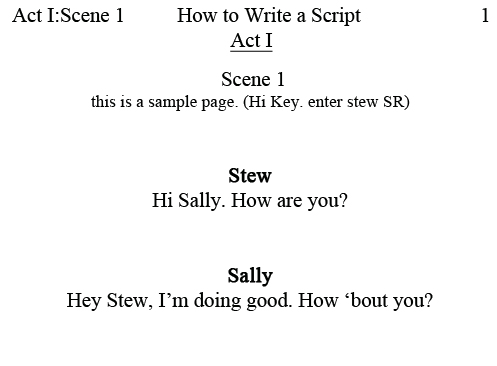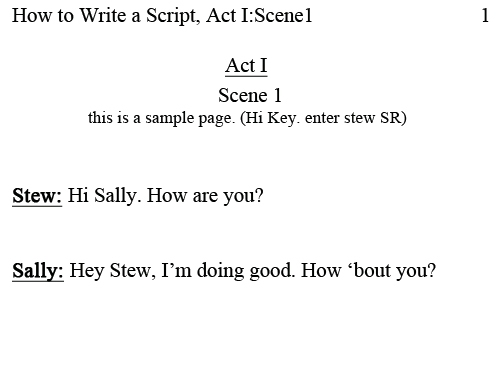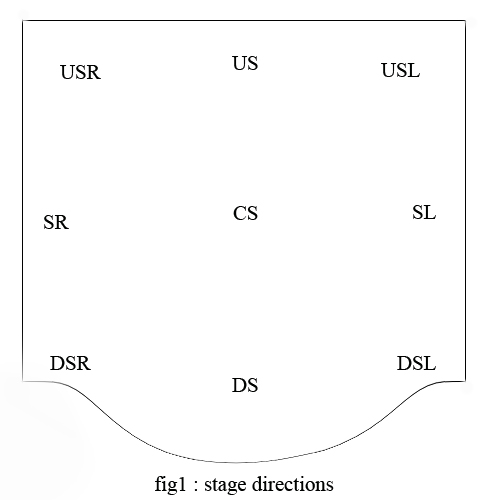
The Need to knows
Here are the general basics about plays, playwriting and theatre you need to know before jumping the gun into a script. These are simple, but important things that need to be learned in writing a good script, and making it appealing, interesting and plausibly useable in the theatric cummunity/industry.
 Formatting Basics
Formatting Basics
The general format of scripts are single spaced, 12 ft. Times New Roman. They include a Cover sheet, title page, prologue and the body, or play itself. In longer, or more complicated plays, an epilogue may be included between each Act, and at the closing, or end, of the play.
It is just and understood rule that Acts are categorized in roman numerals. (IE: I. II. III. IV. etc...) Scenes can be listed in roman numerals or in regular generic numerals, but generally speaking, also follow the roman numeral rule.
Acts and Scenes are to be centered, and underlined at the beginning of each new chapter/scene change, and are typically followed my a short, quick-to-the-p
oint description and scene set up.
Characters can either be listed in bold and centered above their dialogue, OR can be listed in bold underlined followed by a comma just before their dialogue.
Any other notes, such as stage directions, lighting, actions or subscripts, should be listed in italics and enclosed in (parenthesis) or [ brakets ].
Each page should enclude the name of the play, the act and the scene, either in the far left hand corner, or centered in the following format:
Title, Act:Scene
And the page number should be listed in the far right corner.
There are two general formats that are considered acceptable in the field : The centered, and the Direct.
The centered format includes the Act:scene in the far left corner, the Title centered, and the page number in the far right corner to head each page.
All type and writings are centered, regardless of wether it is the Act, Scene dialogue or subtext/subscripts.
Acts are underlined, scenes are not, and characters are bold and centered just above their dialogues/monologues.
The Direct format includes the the Title, Act:Scene in the upper far left corner, and the page number in the upper far right corner.
Acts and scenes are both centered, and underlined.
Characters are can be either bold or underlined but are usually both, and are followed by a comma and their dialogue/monologue and are not centered.
Here is an example of both Centered, and Direct format forms:


Though both formats are acceptable, it is generally understood in the industry that the Centered format is the "proper" format that is widely accepted and worked with. Though the Direct format is used and accepted, is is usually used mainly for rough drafts and quick walk-throughs, though final drafts are usually printed, published and used among production in the Centered Format.
Lighting
Lighting is an important part of your script. It helps set the mood of your scenes, and should be included in your scene set up and description. There is no need to go into detail about candle lighting, twilight, dawn, sunset, flourescent bulbs, 60 watt bulbs, bright sunny day with a little clouds or any other way to describe the lighting of your scene. This is unneccesary and just clutter up your script -- there are four basic categories that lighting falls under, and these short, simple and easy to learn terms are used to describe just about any lighting situations:
Hi Key - which is the most commonly used, is the basic lighting default for scenes unless something specific is needed to set up the mood or specific events/actions in a scene.
Med Key - which is used for indoor scenes that require something other than Hi Key to portray a specific mood or event.
Low Key - this is very dim, used to portray candle light, very dimly light rooms/environment, or for sunset/sunrise or night-time scenes to portray a specific mood.
Black Out - this is only used during scene changes, or if some specific event were to happen that would require the lights to be off - such as a power outage, or a storm scene with lightning effects etc. Another variation of black out is "fade to black" which is commonly used at opening/closing, intermitions and scene changes.
The lighting is usually the fist words in your scene description/set up, as it immediately sets the tone and mood of the scene, and when used in production are important ques for the stage management, production team and stage hands.
Stage Directions
Another important aspect of your script are stage directions. These are the short-hand for the basic directions of the stage. Stage directions become the skeleton of all actions in your play, and are the backbone of your scene set up and your entrance/exit of characters.
The Stage directions are usually the last words in your scene description and setup, and are usually the last words of each scene. They also give instruction to your characters and actors of where to enter, where to walk or 'cross', where to stand and where to exit.
Stage directions describe the basic points of the stage, and are written in the Actor's point of view. That is a very important note to remember, if you get this mixed up, then your play will literally be backwards. This means that your left is their right, your right is their left, etc. If you are in the audience watching, and want an actor to exit to your right, you would write in the script's stage direction to exit Stage Left (SL), because your right would be their left.
Also, when moving back or forth, up or down across the stage, stage directions are wirtten as if you are looking down upon the stage from above. If you want them to step back behing another actor, or to a prop that is set towards the back of the stage or the scene, you would not right is as stepping back, or moving back, it would be written as Upstage. And the reverse apllies for moving forward towards the audience.
There are Nine generall points of the stage used for direction, all other points are noted by tiny marks on the stage that only actors can see while performing. Those usually only apply for very specific directions, everything else follows the general nine points of the stage (see fig.1 for reference)
Center Stage(CS) - which is the very middle of the stage.
Stage Right(SR) - which is the general middle area of the left hand side of the stage.
Stage Left(SL) - which is the general middle area of the right hand side the stage.
Up Stage(US) - which is the general middle area of the stage farthest from the audience.
Down Stage(DS) - which is the general middle area od the stage closest to the audience.
Up Stage Right(USR) - which is the left hand corner farthest from the audience.
Up Stage Left(USL) - which is the right hand corner farthest from the audience.
Down Stage Right(DSR) - which is the left hand corner closest to the audience.
Down Stage Left(DSL) - which is the right hand corner closest to the audience.

The abreviated shorthand are the symbols used to give show direction in the Scripts. For example, if you have Sally and Stew in a scene together. Sally enter at the left, and you want her to walk to Stew who eneter at the right, you would write it like this:
Enter Sally SR, enter Stew SL. Sally crosses SL to Stew.

return to How to write a Script main page
jump to Scripts-Getting Started
jump to Preparing for Production
| Show these comments on your site |
 Stumble!
Stumble!




